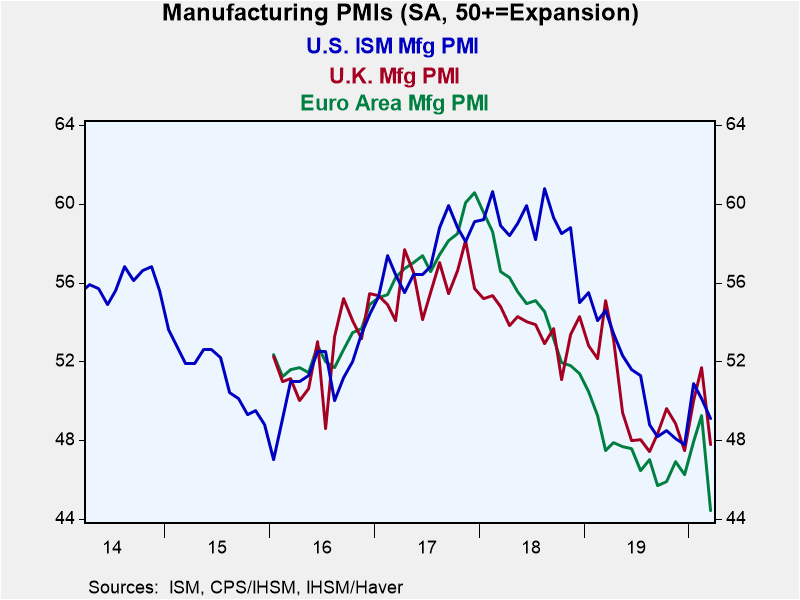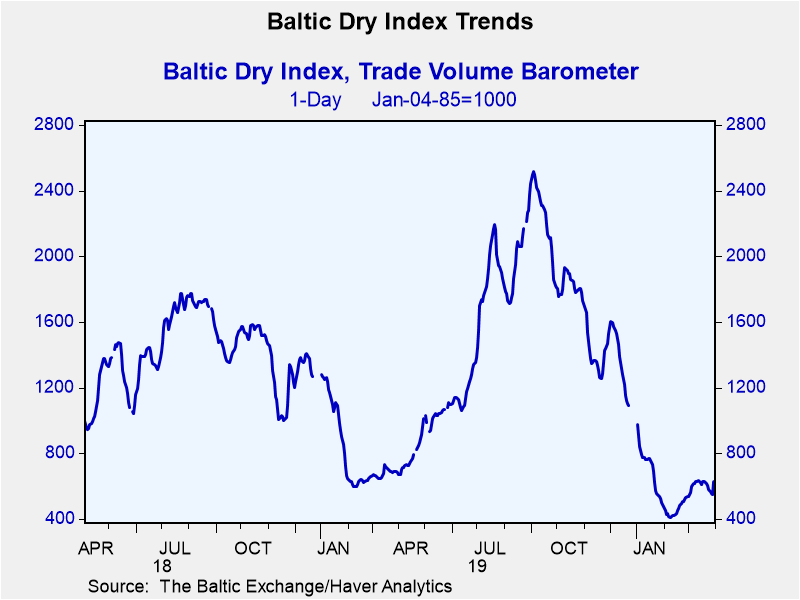 Global| Apr 01 2020
Global| Apr 01 2020Markit PMIs Fall and Show Weakness in March
Summary
Of the eighteen observations on manufacturing PMIs in Table 1, only two entries China and Taiwan improve month-to-month (India and Mexico are ‘unchanged on the month because we use their data from February to fill out the table since [...]
 Of the eighteen observations on manufacturing PMIs in Table 1, only two entries China and Taiwan improve month-to-month (India and Mexico are ‘unchanged on the month because we use their data from February to fill out the table since they have not reported fresh data for March).
Of the eighteen observations on manufacturing PMIs in Table 1, only two entries China and Taiwan improve month-to-month (India and Mexico are ‘unchanged on the month because we use their data from February to fill out the table since they have not reported fresh data for March).
This month the Asian region weakened overall, but it is not as weak as the EMU where Germany slipped considerably on the month; in Asia China mounted a huge one-month rebound. We take only simple averages in the table of the data and do not weight them for GDP. So China’s impact on the Asia total is small.
What is clear is how breadth has slipped. Over three-month, six-month, and 12-month, Europe skipped along on readings just below 47 with Asia riding a trend of diffusion between 49 and 50, indicating only mild setbacks in manufacturing. In March, Asia has slipped to a reading of 47.4 with the euro area (a weighted statistic) at 44.5. The impact of the coronavirus on output has been spreading.
There are a few surprise statistics this month. For example, Italy and the EMU region both recorded lower rates of unemployment. For the EMU, it is the lowest rate since the Great Recession. However, we know what else is happening there as the virus spreads and that unemployment reading will not stand. Germany also recorded a surprising strong gain in retail sales for the second month in a row. That is another trend that will not stand. The PMI data sketch a clear picture of weakness and weakening with the notable exception of China and Taiwan.
What is not yet clear is how weak conditions are going to get. A month ago, the Chinese PMI was a real eye opener – a shocker- with its manufacturing gauge falling to 40.3 and with the services reading even weaker. But this month, China is back above 50 showing an amazing manufacturing recovery. Part of this is in the nature of PMI data that focus on the breadth of month-to-month changes instead of on strength. In all likelihood, the Chinese data do not indicate that the Chinese economy is really back to where it was before the coronavirus sucker-punched it. PMIs are not the best or most comprehensive economic indicators, but they are telling and often early indicators of the next turn of the economy.
The 12-month to six-month to three-month progression shows France, Japan, China, Brazil, and Vietnam getting progressively weaker on that timeline. Only Turkey is getting progressively stronger.
If we look broadly at the distribution of readings for the 18 countries and the euro area in Table 1, we can see greater weakness over the last year than over the previous 12 months. Conditions are worsening over the last three months and then getting decidedly weaker in March. PMI readings in the 50 to 55 range are relatively normal. They signal mild increases in output. As signals rise above 55 they are showing considerable strength. Readings below 50, of course, signal contraction in manufacturing. The past four years have been ‘difficult’ with 32% of the PMI readings in the 40-to-50 cohort, indicating output declines have been lingering and pervasive for a significant number of reporters. But there have also been about 10% of the reporters with heated up activity above 55. However, that sort of strength has not been seen since January. There are no countries in that cohort for the last two months. The fall-off seems more severe because over the previous 12 months the global economy has heated up. Over the last 12 months it has been slipping and now it is being dragged down by the coronavirus attenuation policies independent of the economic cycles it was previously running. Because of ongoing economic lockdowns and social distancing, we expect conditions globally to get much worse.
Table 1 also gives queue rankings that place this month’s reading in a queue of data back to January 2016. Ranked in this way the current readings are nothing short of abysmal. India has a relatively high ranking, the only ranking above its 50th percentile (50% marks an entry’s median gain for the period). India’s reading is at a very high 94th percentile, but only on a relatively modest diffusion reading of 54.5 (representing actual data from February). The euro area, France, the U.S., Canada, Indonesia, Vietnam and South Korea all are sitting on their respective weakest readings of this entire period. And there is probably a lot more weakness to come.
 Trade tends are still dead-to-muted
Trade tends are still dead-to-muted
The global economy is all but coming to a standstill as output pauses when people stay shuttered in their homes and do as little as they can to engage their neighbors. There is also a death toll that has struck more people with re-existing conditions and old people especially those in their 80s. The coronavirus is still rampaging and has yet to turn the corner in the U.S. and other places. China seems relatively corona-free; there have been no new indigenous cases reported in Wuhan; Still, China is watching its boarder closely since travelers are still a risk.
Fewer economists are looking for that fabled ‘V’ shaped recovery once it comes. It is clear that recovery from the virus will not be sudden; it will be stepwise. There will be careful actions taken to ensure there is not backsliding. That sort of re-engagement suggests that growth will get back to trend more deliberately rather than speedily. The timing for getting control of the virus is still uncertain. Health officials are still wary of a second wave or a second rising. That fear has led to the adoption of longer confinement periods (shelter-in-place). There is still a lot unknown. Testing is still ramping up globally. Getting an accurate, quick, diagnosis will be an important way to get control of this nefarious ‘stealth virus that is highly contagious and spreads when people are asymptomatic. Progress is being made, but it is hard to handicap that and that means it is impossible to make any reasonably confident economic forecast. Take care, one and all. If you are in good health and you are young, you are not at much risk. In that case, be careful of your behavior around the old who could die from an exposure that might not even debilitate you.
Robert Brusca
AuthorMore in Author Profile »Robert A. Brusca is Chief Economist of Fact and Opinion Economics, a consulting firm he founded in Manhattan. He has been an economist on Wall Street for over 25 years. He has visited central banking and large institutional clients in over 30 countries in his career as an economist. Mr. Brusca was a Divisional Research Chief at the Federal Reserve Bank of NY (Chief of the International Financial markets Division), a Fed Watcher at Irving Trust and Chief Economist at Nikko Securities International. He is widely quoted and appears in various media. Mr. Brusca holds an MA and Ph.D. in economics from Michigan State University and a BA in Economics from the University of Michigan. His research pursues his strong interests in non aligned policy economics as well as international economics. FAO Economics’ research targets investors to assist them in making better investment decisions in stocks, bonds and in a variety of international assets. The company does not manage money and has no conflicts in giving economic advice.






